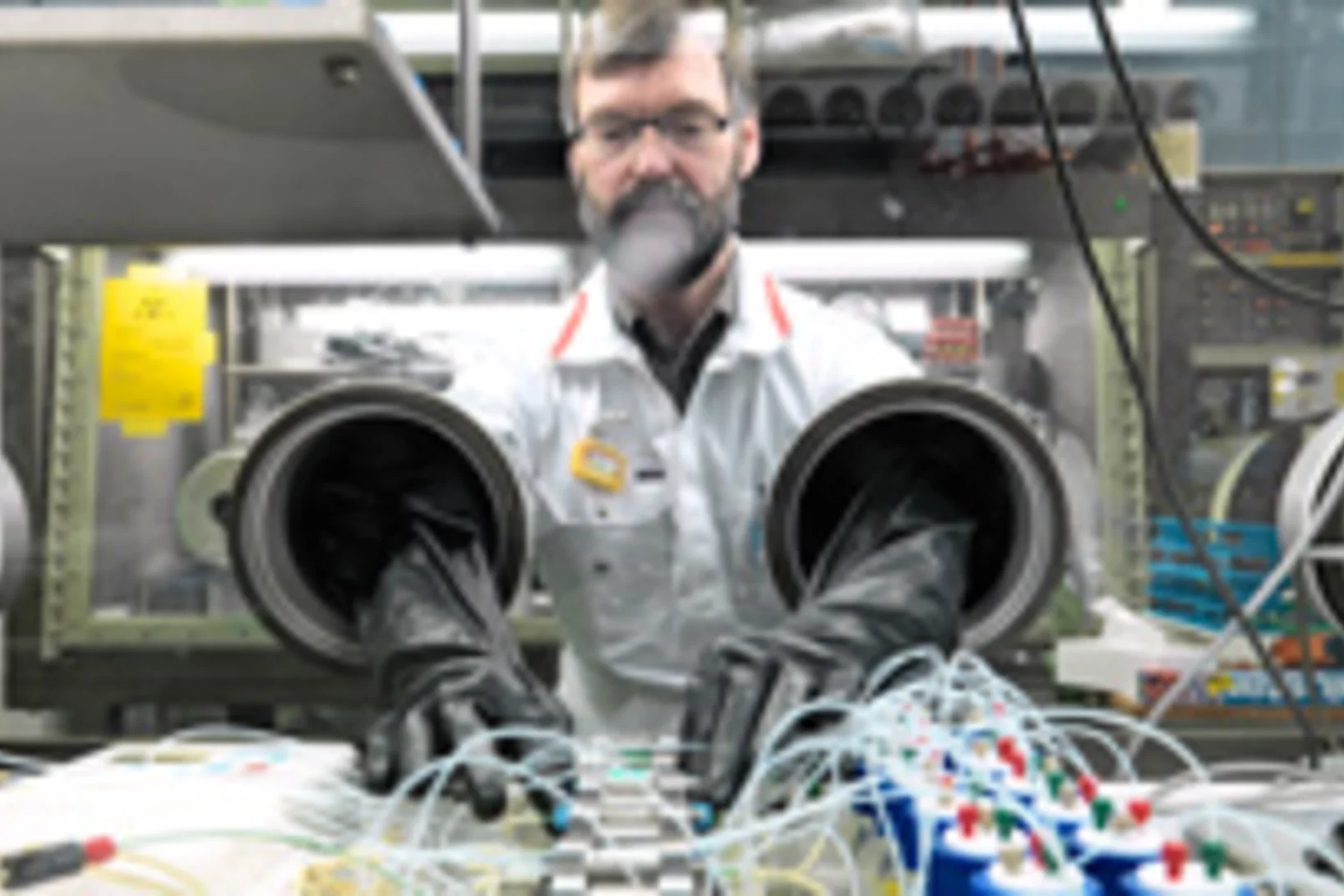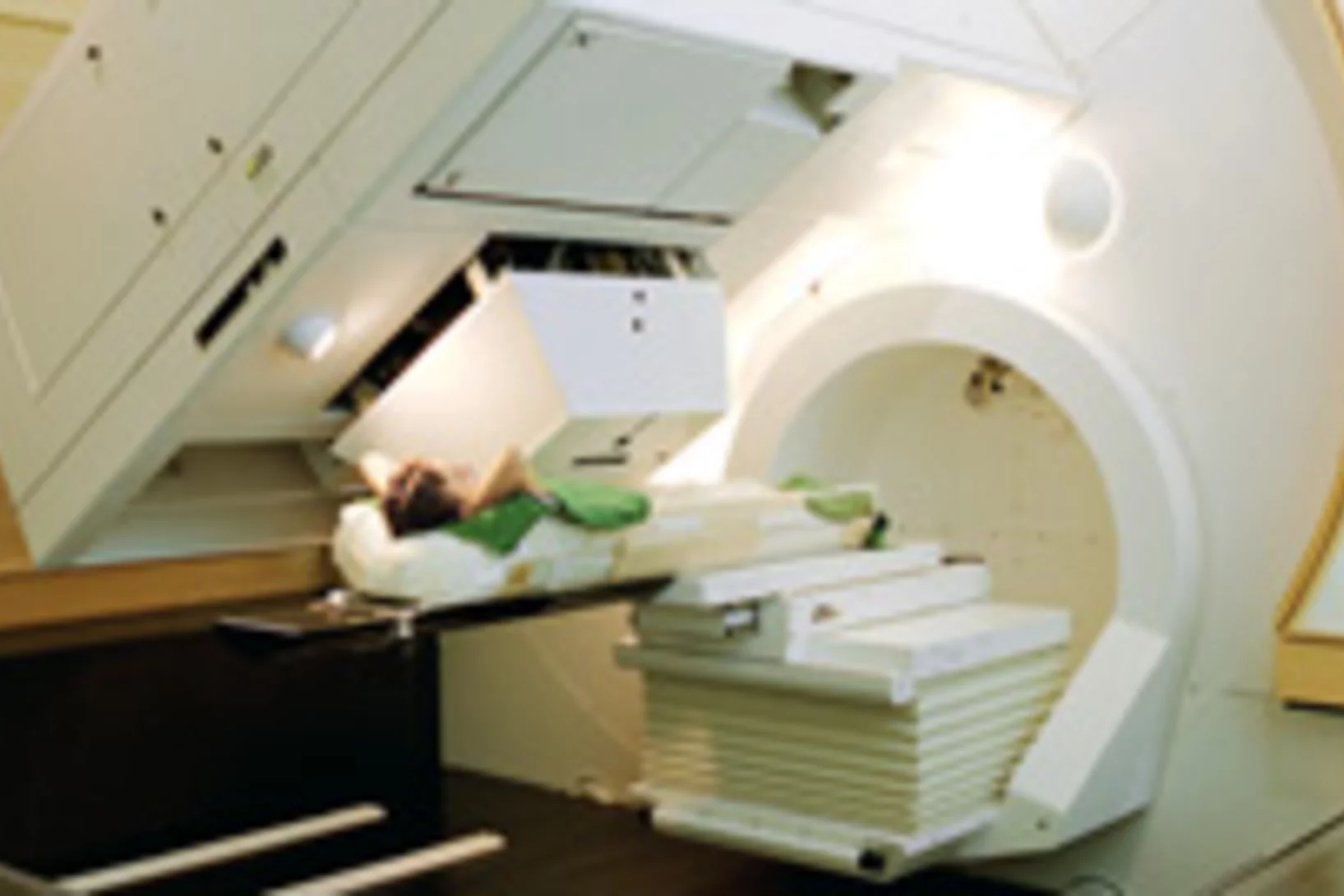A l’Institut Paul Scherrer, les scientifiques cherchent des réponses à la question essentielle des structures élémentaires de la matière et des principes fondamentaux de fonctionnement dans la nature. Ils étudient la structure et les propriétés des particules élémentaires – les plus petits composants de la matière – ou se penchent sur la question de savoir comment les molécules biologiques sont structurées et remplissent leur fonction. Les connaissances qu’ils acquièrent de la sorte ouvrent de nouvelles pistes de solution en sciences, en médecine ou dans le domaine des technologies.
Pour en savoir plus, reportez-vous à Aperçu Fondements de la nature
Chemie-Nobelpreisträger 2009 forscht am Paul Scherrer Institut
Das Paul Scherrer Institut gratuliert Professor Venkatraman Ramakrishnan zum Erhalt des diesjährigen Nobelpreises für Chemie. Ramakrishnan ist langjähriger Nutzer der Synchrotron Lichtquelle Schweiz SLS des Paul Scherrer Instituts und führt hier regelmässig Experimente zur Bestimmung der Struktur von Ribosomen durch, für die er nun den Nobelpreis erhalten hat.Cette actualité n'existe qu'en allemand.
Un stockage final sûr – étude du contexte spécifiquement suisse
Les déchets radioactifs produits par les centrales nucléaires ou issus de la médecine, de l'industrie et de la recherche doivent être isolés de l'environnement et de l'espace vital de l'Homme pendant de très longues périodes. Les experts du PSI se penchent depuis des années sur les questions scientifiques relatives à la sécurité des dépôts de stockage géologique définitif. La recherche effectuée au PSI se concentre principalement sur les phénomènes physico-chimiques ayant lieu dans les dépots de stockage définitif. L'objectif est de réaliser une description réaliste des risques liés au stockage des déchets radioactifs.
Mémoire du climat passé figée dans la glace
Les glaciers peuvent contenir des informations précieuses sur le climat et la composition de l'atmosphère du passé. Les chercheurs du PSI entreprennent régulièrement des recherches sur le terrain dans différentes régions, afin d'y prélever des carottes de glace. En laboratoire, la carotte est découpée et dégelée centimètre après centimètre, afin d'en analyser la composition. Cela permet de reconstruire différents paramètres climatiques.
Structures et incidences des systèmes énergétiques nationaux et internationaux – les objectifs climatiques pour la Suisse
L'institut Paul Scherrer analyse les structures et les incidences des systèmes énergétiques nationaux et internationaux. Une étude dans laquelle le PSI a émis des recommandations sur ce que pourraient être les objectifs climatiques nationaux de la Suisse a ainsi été menée en 2007. Cette étude a également présenté les faits sur lesquels repose le système énergétique suisse, ainsi que les objectifs qui pourraient être atteints. La protection du climat est l'un des domaines les plus importants de la politique énergétique nationale des prochaines années. D'ici 2050, il est prévu de réduire les émissions de CO2 de la Suisse d'au moins 50 %. Dans ce contexte, une meilleure efficacité énergétique s'impose, mais elle n'est pas à elle seule déterminante.
Ticket für die Reise durch die Zelle
Publikation in Cell. Forscher entdecken Mechanismus für wesentliche Erkennungsvorgänge in lebenden Zellen. Über ihre Ergebnisse berichten die Forscher in der neuesten Ausgabe der Fachzeitschrift Cell.Cette actualité n'existe qu'en allemand.
Treibstoff aus Sonnenenergie
Le chercheur en énergie solaire, Aldo Steinfeld, de l'Institut Paul Scherrer et de l'ETH Zurich reçoit le Prix de l'association américaine des ingénieurs en mécanique (ASME) pour ses travaux de recherche dans le domaine des énergies renouvelables.Cette actualité n'existe qu'en allemand.
Neues Verfahren ermöglicht Steuerung von elektronischen Materialeigenschaften
Forschenden ist es erstmals gelungen, dünne Schichten mit steuerbaren elektronischen Eigenschaften herzustellen. Diese Entdeckung könnte für zukünftige Anwendungen in der Sensorik und der Computertechnologie von grosser Bedeutung sein. Die Arbeiten wurden im Wissenschaftsmagazin Science veröffentlicht.Cette actualité n'existe qu'en allemand.
Watching atoms move
A complete characterization of the unit cell dynamics of a laser-excited tellurium crystal is demonstrated using femtosecond x-ray diffraction. The analysis offers a quantitative measure of the unit cell dynamics without making any assumptions on the symmetry of the excited-state motion.
Der Aargauer Regierungsrat auf Informationsbesuch am Paul Scherrer Institut (PSI) in Villigen AG
Auch in neuer Zusammensetzung ein Zeichen gesetzt. Der Aargauer Regierungsrat in corpore hat sich heute am PSI, dem grössten öffentlichen Forschungsinstitut der Schweiz, aus erster Hand über dessen zukünftige Forschungsschwerpunkte informieren lassen. PSI-Direktor Joël Mesot und sein Team führten die Gäste durch die einzigartigen Grossanlagen des Instituts und stellten unter anderem auch das neue Grossprojekt des PSI, den SwissFEL, vor.Cette actualité n'existe qu'en allemand.
Innovative Ideen und kreatives strategisches Handeln
Das Paul Scherrer Institut präsentiert aktuelle Themen auf seiner Jahresmedienkonferenz. Das Paul Scherrer Institut PSI ist für seine Spitzenforschung bekannt. Wie diese Spitzenposition zustande kommt und wie man sie langfristig sichern kann, erfuhren Medienvertreter bei der Jahresmedienkonferenz am 23. Juni. Aber nicht nur die eigentliche Forschung erfordert innovative Ideen: auch kreatives strategisches Handeln ist wichtig, so dass beispielsweise stets genug begabte junge Forscher den Weg ans PSI finden. Dafür sollen insbesondere Kooperationen mit Hochschulen sorgen, von denen die gemeinsame Professur gerade besonders aktiv vorangetrieben werde betonte Joël Mesot, der Direktor des Instituts.Cette actualité n'existe qu'en allemand.
Confinement-Induced Orientational Alignment of Quasi-2D Fluids
Extreme confinement is known to induce ordering of the fluid, thereby affecting its properties.
Advanced phase contrast imaging using a grating interferometer
Conventional absorption based X-ray microtomography can become limited for objects showing only very weak attenuation contrast at high energies. However, a wide range of samples studied in biology and materials science can produce significant phase shifts of the X-ray beam and thus phase contrast X-ray imaging can provide substantially increased contrast sensitivity.
Komplexe in den Griff bekommen
Die meisten Vorgänge in lebenden Zellen werden von molekularen Maschinen aus vielen Proteinen ausgeführt. Wissenschaftler von PSI und EMBL haben ein automatisiertes Verfahren zur Herstellung von solchen Multiprotein-Komplexen für die Forschung entwickelt.Cette actualité n'existe qu'en allemand.
Electrons with opposite spins move in opposite directions
In one dimension, there are only two ways to move: left or right. This leads to some peculiar properties for one-dimensional systems on the atomic scale.
Forschung live erleben
Krebsbehandlung mit Protonen – präzise und effizient. Das Paul Scherrer Institut PSI lädt zu einer Vortragsreihe zu spannenden Themen aus der Welt der Wissenschaft ein. Am Mittwoch, 3. Juni 2009, wird dem Publikum von 19 bis 21 Uhr in einem spannenden und allgemein verständlichen Vortrag die Krebsbehandlung mit Protonen vorgestellt. Im Anschluss an das Referat ermöglicht das PSI eine Besichtigung der Protonentherapie. Beim Apéro besteht zudem die Möglichkeit, mit den Forschern zu diskutieren. Die Teilnahme ist kostenlos, die Platzzahl ist beschränkt. Telefonische Anmeldung unter 056 310 21 11.Cette actualité n'existe qu'en allemand.
Phonon squeezing
Photon squeezing has been the subject of intense interest in the field of quantum optics, since it serves as a unique demonstration of the quantum nature of light. On a practical level, squeezing offers opportunities to make interferometric measurements much more precise than would normally be allowed by quantum uncertainty limits.
Putting the squeeze on phonons
Photon squeezing has been the subject of intense interest in the field of quantum optics, since it serves as a unique demonstration of the quantum nature of light. On a practical level, squeezing offers opportunities to make interferometric measurements much more precise than would normally be allowed by quantum uncertainty limits. In principle, the physics of squeezing may be applied to many different types of bosons.
CCEM mit Paul Scherrer Institut und Empa am WestFest
Für CO2-neutrale, saubere Mobilität. Mit einem grossen Fest feiert Zürich vom 24. bis 26. April 2009 die neue Autobahn-Westumfahrung. Am WestFest sind das Paul Scherrer Institut PSI und die Empa am Stand des Kompetenzzentrums für Energie und Mobilität im ETH-Bereich CCEM präsent. Wissenschaftler zeigen hier Forschungsarbeiten aus den Bereichen Abgasnachbehandlung von Dieselmotoren, Erdgas-/ Biogasantriebe mit der nachhaltigen Erzeugung von Methan sowie Brennstoffzellenantrieb mit der Kette des nachhaltig erzeugten Wasserstoffs.Cette actualité n'existe qu'en allemand.
Rückkehr in die Berufstätigkeit
Eine Chance für Naturwissenschaftlerinnen und Ingenieurinnen. Jungen Wissenschaftlerinnen und Ingenieurinnen, die nach Zeiten der familiären Verpflichtung die Rückkehr in die Berufstätigkeit planen, will das Paul Scherrer Institut (PSI) den Wiedereinstieg erleichtern.Cette actualité n'existe qu'en allemand.
A fast selenium derivatization strategy for crystallization and phasing of nucleic acid structures
The growing number of biologically important nucleic acid sequences (DNA and RNA) demands a fast and reliable method for their de novo three-dimensional structure determination. In this work, we described a fast and inexpensive strategy for the crystallization and phasing of structures of nucleic acid and nucleic acid/protein complexes.
Im Unterschied liegt die Stärke
Warum CERN und PSI völlig verschieden sind und doch Herausforderungen gemeinsam angehen. Am heutigen Gründonnerstag haben das Paul Scherrer Institut PSI und die Europäische Organisation für Kernforschung CERN ihre langjährige Kooperation formalisiert. Dazu unterzeichneten sie einen Vertrag zur Zusammenarbeit.Cette actualité n'existe qu'en allemand.
Physik und Medizin gemeinsam auf der Bühne
Im Kinokomplex Trafo Baden wird vom 19. bis 21. März 2009 die 13. Jahreskonferenz der Scientific Association of Swiss Radiation Oncology (SASRO) ausgerichtet. Für die Organisation der Konferenz verantwortlich ist das Paul Scherrer Institut PSI, das mit seiner Protonentherapie eines der schonendsten Verfahren zur Krebsbehandlung anbietet. An der Konferenz des wissenschaftlichen Verbandes der Schweizer Radio-Onkologen sind die beiden Hauptthemen Strahlentherapie mit hoher Präzision sowie die Strahlentherapie in der Kinder- und Jugendmedizin.Cette actualité n'existe qu'en allemand.
Exciting Heavy Metal
Photocatalysts play an important role in a broad range of applications, from photochemical conversion of light energy into chemical energy through to initiating novel chemical reactions. One family of compounds that has attracted much attention is the dinuclear d8-d8 platinum, rhodium and iridium complexes that have a highly reactive electronic excited state.
Entsteht Supraleitung doch ganz anders?
Publikation in Nature Materials. Ergebnisse vom Paul Scherrer Institut stellen gängige Theorien der Hochtemperatursupraleitung in Frage.Cette actualité n'existe qu'en allemand.
Quand les supraconducteurs donnent le ton aux ferromagnétiques
Publication au Nature Materials. Des chercheurs de l'Université de Fribourg et de l'Institut Paul Scherrer (PSI) ont découvert une nouvelle forme de coexistence entre la supraconductivité et le magnétisme qui à l'avenir pourrait s'avérer utile dans des applications techniques, par exemple dans le domaine des ordinateurs quantiques.
Femtosecond molecular spin crossover
X-ray absorption spectroscopy is a powerful probe of molecular structure, but it has previously been too slow to track the earliest dynamics after photoexcitation. We investigated the ultrafast formation of the lowest quintet state of aqueous iron(II)tris(bipyridine) upon excitation of the singlet metal-to-ligand-charge-transfer (1MLCT) state by femtosecond optical pump/x-ray probe techniques based on x-ray absorption near-edge structure (XANES).
Dans l'avenir, le bois de chauffe sera distribué par les conduites de gaz
Des chercheurs de l'Institut Paul Scherrer se sont vu décerner le Watt d'Or 2009 pour un procédé permettant de produire du gaz naturel à partir du bois.
Décalage observé entre les températures
PubliCation au Geophysical Research Letters. De nouveaux résultats issus de la recherche en climatologie à partir de carottes de glace de l'Altaï en Sibérie. Ce qui est particulièrement remarquable, c'est que les températures reconstituées suivent le cycle d'évolution de l'activité solaire avec un retard de 10 à 30 ans.
Moleküle bei der Arbeit fotografiert
Publikation in Online-Ausgabe von Science. Röntgenblitze am Paul Scherrer Institut zeigen, wie sich Moleküle während des Ablaufs einer chemischen Reaktion verändern.Cette actualité n'existe qu'en allemand.
Percer à jour le sourire du bouddha
Au Paul Scherrer Institut, les chercheurs en neutronique fêtent 20 années d'adhésion de la Suisse à l'Institut Laue-Langevin de Grenoble






























